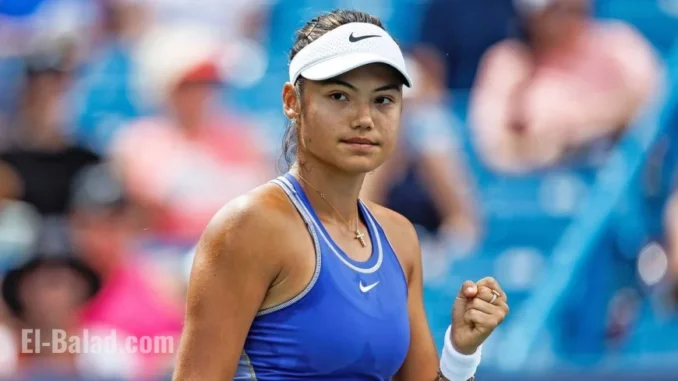
In the dazzling yet brutal theater of professional tennis, where one blistering forehand can rewrite destinies, Emma Raducanu’s 2025 season has been nothing short of a blockbuster saga—packed with triumphant roars, gut-wrenching collapses, and a defiant vow to reclaim her throne. The 22-year-old British firebrand, whose fairy-tale 2021 US Open victory at just 18 sent shockwaves through the sport, has endured a whirlwind year that tested every fiber of her being. From stalker scares and coaching upheavals to scorching Asian retirements and a damning fan poll branding her trophy hopes as “never,” Raducanu faced it all. Yet, as she shuts down her campaign early for vital recovery, her eyes are firmly locked on a scorching 2026 comeback. “We’re already planning pre-season,” she revealed this week, her voice brimming with unshakeable resolve. This isn’t defeat—it’s the prelude to domination.
Imagine stepping onto the court as the nation’s golden girl, only to navigate a minefield of personal and physical chaos. Raducanu’s year ignited with promise but flickered under pressure from the outset. Off-court turmoil struck first in Dubai, where a chilling stalker incident mid-match left her in tears, spotting a man with “fixated behaviour” lurking in the stands. Security swooped in, but the emotional scar lingered, compounding the shock of her coach Nick Cavaday’s sudden departure due to his own health battles. Adrift at season’s start, she linked arms with Francisco Roig—the Nadal-whisperer from Spain—in August, a partnership that sparked immediate magic. Their chemistry? Electric. “It’s been tough, but I need to prioritize recovery,” Raducanu admitted after her latest withdrawal, yet she extended Roig’s contract through 2026, signaling a bedrock of stability amid the storm.
On the court, 2025 was a testament to her warrior spirit: a career-high 50 matches played, 28 victories etched in sweat, and a meteoric climb back to world No. 29—her highest ranking in over three years. Peaks soared skyward—a blistering quarter-final in Miami, where her laser-guided groundstrokes shredded defenses; a semi-final surge in Washington, thriving in D.C.’s humid haze; and a gritty third-round exit at the US Open, bowing to Elena Rybakina after pushing the Kazakh powerhouse to the brink. Wimbledon offered a heartbreaker, taking world No. 1 Aryna Sabalenka to the wire in a grass-court thriller that had Centre Court on its feet. Even the majors showcased her mettle: third-round battles against Iga Swiatek at the Australian and French Opens, where she traded blows with the queen of clay before fatigue felled her.
But valleys plunged deep, carving lessons in resilience. Illness and injury, those cruel gatecrashers, turned glory into gloom during her Asian swing. In Wuhan, humidity sapped her strength; trailing Ann Li 6-1, 4-1, medics checked her soaring blood pressure and temperature as she gasped, “I was really struggling.” A week later in Ningbo, the script replayed: a first-set triumph over Zhu Lin dissolved into back spasms and dizziness, forcing another retirement against Yuliia Starodubtseva. Ten days of viral woes culminated in pullouts from Tokyo and Hong Kong, sealing her season’s early end. These weren’t flukes—they echoed a body battered by prior surgeries (wrist and ankle in 2023-24) and the burnout of her breakthrough year. At 22, she’s weathered more than veterans twice her age, her frame a battlefield of overtraining and tropical tolls.
Then came the “crushing triple blow,” a verdict that stung like a double-fault under pressure. First, health fragility: recurring dizziness, fatigue, and back twinges paint a player whose weaponized athleticism now demands surgical care. Second, ranking roulette: teetering at No. 29, she’s gambling her Australian Open seeding—vital to evade early Swiatek or Sabalenka showdowns—without those final points. Third, and most brutal: a fan poll where 55 percent declared she’d “never” lift another trophy, with just 2 percent betting on 2025 (now impossible), 26 percent on 2026, and 17 percent later. It’s a public gut-punch after four barren years since Flushing Meadows, amplifying the weight of Britain’s tennis torch. “The pressure is immense,” an insider confided, capturing the hype’s heavy crown.
Yet, Raducanu’s narrative thrives on defiance, not despair. From Bromley’s council courts to global stardom, she’s the qualifier-turned-champion who flipped the script on elitism. Her summer renaissance—consistent deep runs, a loosened swing—hinted at untapped elite potential. With Roig plotting pre-season drills in the Spanish sun, she’s not rebuilding; she’s reloading. Envision January 2026: Melbourne’s Rod Laver Arena, Raducanu seeded and surging, her forehand a thunderclap silencing doubters. Past foes like Rybakina and Sabalenka? Fuel for fire. Swiatek? A rivalry reborn.
This rollercoaster isn’t a detour—it’s her origin story’s sequel. Fans who chanted her name at Wimbledon now whisper of redemption arcs rivaling Andy Murray’s grit or Johanna Konta’s breakthroughs. Darts with her trademark poise, Raducanu’s 2025 forged diamonds from debris: 28 wins, top-30 return, and a coach locked in. As she rests, visualizes, and rebuilds, the message is clear: the Nuke isn’t dimming—she’s detonating. In tennis’s grand marathon, where falls precede flights, Emma Raducanu eyes not just a comeback, but a conquest. The world better brace—Simply the Best is evolving into Unstoppably Elite.
Leave a Reply